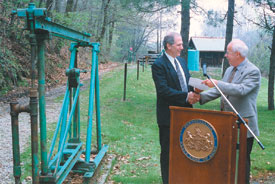International
World’s oldest producing oil well hits 140For the history fans among our readers, we bring you a different kind of news item. Yes, it’s not every day that the world’s oldest producing oil well has a milestone birthday. Folks in northwestern Pennsylvania (Titusville) were quite excited last month, as they celebrated the 140th birthday of McClintock No. 1, which recently underwent remedial work that restored its health. A property of the State of Pennsylvania, McClintock No. 1 labors on behalf of the Drake Well Museum. "The well was drilled in August 1861, but we don’t know on which day it was completed and began producing," said the museum’s director, Barbara Zolli. "The well was "kicked down" (drilled by foot) by J. D. Angier, to a 620-ft depth. At one point, it produced 50 bopd from the Third sand." Originally called the Colby well, McClintock No. 1 is not far from the famous well drilled by Colonel Edwin Drake in 1859. It was pumped, along with other nearby wells, by two brothers, John and Joe Bowers, until the late 1890s, followed by a son of John Bowers until 1919. The site was then purchased by Brundred Oil Corp. and produced by that firm until September 1952. At that point, Quaker State Oil Refining Corp. bought the property and subsequently pumped McClintock No. 1 a few times each year, to keep it as the world’s oldest well in continuous, year-to-year production.
In 1995, Quaker State initiated work to transfer the well to the museum. While Pennsylvania legislators worked on a bill to sanction the transfer, the well was temporarily deeded to The Colonel Inc., the museum’s volunteer membership group. The bill finally passed in late 1999, and official transfer took place during a well site ceremony in May 2000. A year later, the museum pumped the well on the anniversary of the transfer, but problems emerged. "We got a lot of brine and very little oil," said Ms. Zolli. "So, we called in some experts from among members of the Independent Oil and Gas Association of Pennsylvania. They put some dye into the well, which confirmed after about 24 hr that we had a matchstick-sized leak in the tubing." Team members eventually replaced the tubing with sections donated by a local firm. A new production test run was attempted in the first week of August, and 9 bbl of oil were produced without incident, or about 1 to 2 bpd. "One of our major challenges has been brine disposal, since it all has to be trucked out," said Ms. Zolli. "Local operators have been very good about helping out, but I think they often do so at a loss to themselves. What we’re now looking for is a partnership with a regional refinery that would help us support the well. Quaker State left us with an endowment, but I’m trying not to spend any of it. We do raise a small amount of money by bottling some of the oil produced from McClintock No. 1 as souvenirs." Readers interested in more information or offering support to McClintock No. 1 and the Drake Well Museum can phone Ms. Zolli at (814) 827-2797 or e-mail her at bzolli@state.pa.us. Updated Canadian numbers. Despite our best-laid plans, some of the statistical data that we request each summer for our August forecast / review issue inevitably straggles in late. This was the case this year for some Canadian data. With the new data included, we now see a nearly
dead-even split between the number of Canadian wells (2,334) that our survey group drilled in first-half 2001
and the number (2,322) that they will drill in the second half. In fact, the first-half and second-half well
totals are roughly even for most of the provinces. Three trends do reveal themselves in our sampling. First,
wildcat drilling will be up by a third. Second, the share of total wells drilling for gas is dropping to 60%
from 71%. Last, horizontal drilling in the group will rise 13%.
|
- Applying ultra-deep LWD resistivity technology successfully in a SAGD operation (May 2019)
- Adoption of wireless intelligent completions advances (May 2019)
- Majors double down as takeaway crunch eases (April 2019)
- What’s new in well logging and formation evaluation (April 2019)
- Qualification of a 20,000-psi subsea BOP: A collaborative approach (February 2019)
- ConocoPhillips’ Greg Leveille sees rapid trajectory of technical advancement continuing (February 2019)




